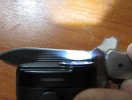I was too self-confident, not having a good magnifying glass or USB microscope at hand. I thought I was removing burrs, but it turns out I was rather straightening or pulling it out. This became clear quite recently when I became interested in drawing and needed to sharpen pencils. Pastel pencils turned out to be very abrasive and fragile, as it turned out, they contain volcanic pumice (kohinoor gioconda pencils). If the knife is not sharp, it breaks off the lead during sharpening. And after each sharpening of the pencil I need to sharpen Buck 425 420hc again, the cutting edge turns to the side. It turned out to be a burr, which I thought I had removed... Thanks to an article by a cool guy with an electron microscope (site scienceofsharp), I realized that I should try diamond paste with a piece of leather glued to a piece of wood. Found 1 micron paste. This really had an effect, the knife began to last for 3-4 pencil sharpenings! The rest of the sharpening process remains the same - I finish with India Fine and then a leather board
Recently bought a knife with m390, it was difficult to sharpen, something is wrong with heat treatment. A guy with the nickname OldTor from our local forum helped a lot with advice. I liked one of the tips so much that I decided to share it here. This is a homemade device for maintaining a constant angle. It is also very suitable for those who have carpal tunnel syndrome and their hands quickly go numb. This is his video. The device itself can be made from improvised means for very little money. The main thing is a flat surface, since the device rests on this surface, which should be parallel to the stone
Photo of the some options:
Explore this photo album by Oleg Gavrish on Flickr!

www.flickr.com
Найдётся всё
disk.yandex.ru
They are also sold ready-made, I liked the Hapstone T1
Pencil Gioconda 8804. After applying diamond paste to the skin, the knife can withstand more sharpenings. I store the board itself in a clean, wrapped bag so that abrasive dust from the air does not get on it. Something is wrong with the brightness, the video turned out a bit dark






